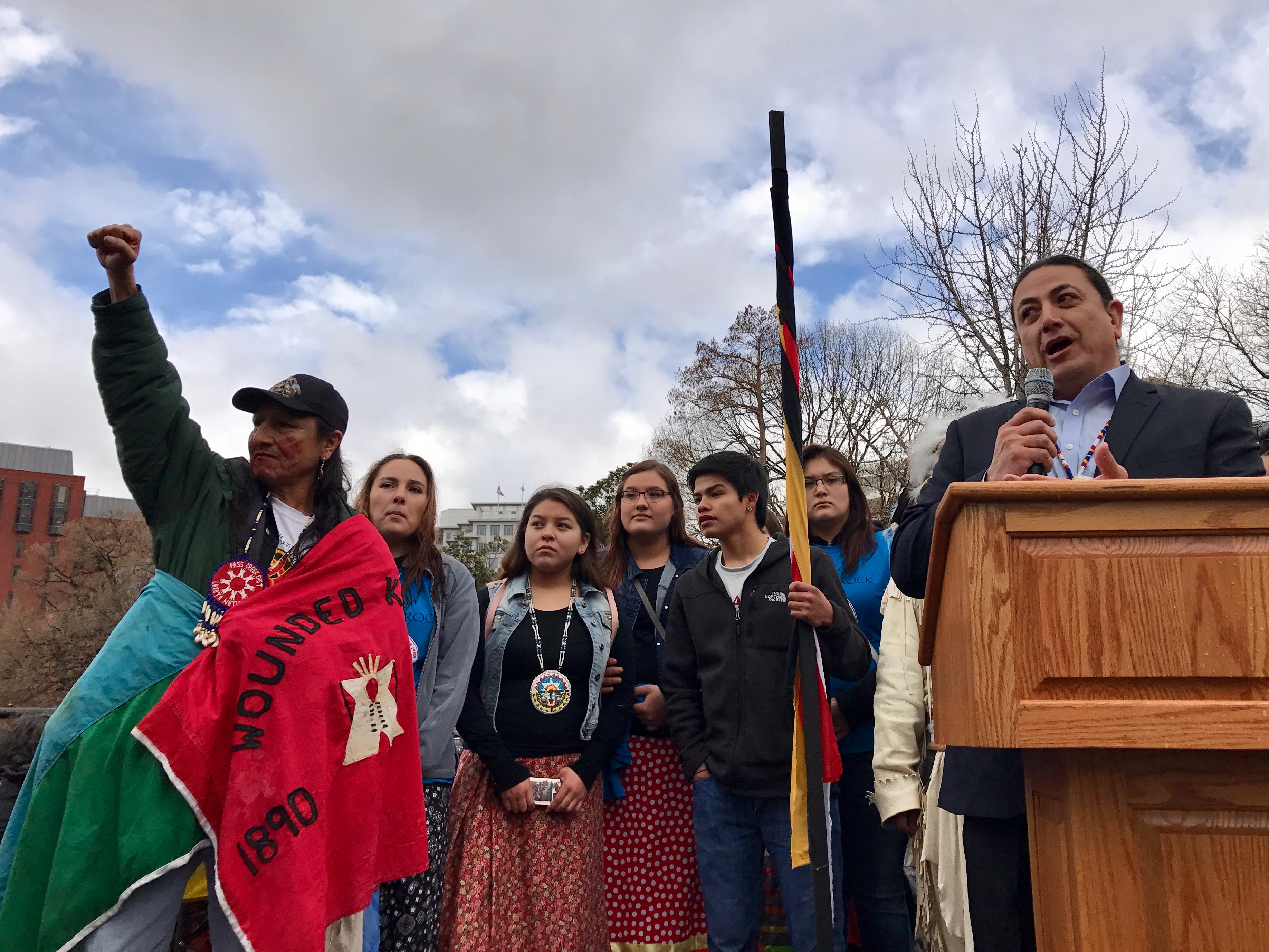The
Dakota Access Pipeline is finally fully operational, months after intense tribal opposition forced the wealthy backers to delay the controversial project.
Thanks to
President Donald Trump, the $3.8 billion crude oil pipeline began its first shipments on Thursday. Without his approval, the project would still be in limbo.
But just four days after taking office,
Trump ordered his administration to "expedite" its review of the project. Barely two weeks after that, the
final portion in North Dakota was approved over the objections of Indian Country and before the completion of a more stringent review of the impacts on treaties, sacred sites and water resources.
With doors shut in the nation's capital after eight years of friendly relations under
Barack Obama, tribal opponents are now resting their hopes in the federal court system. Motions are pending to stop the flow of oil through a pipeline whose construction sparked a
worldwide movement.
“Now that the Dakota Access Pipeline is fully operational, we find it more urgent than ever that the courts and administration address the risks posed to the drinking water of millions of American citizens,” Chairman Dave Archambault II of the
Standing Rock Sioux Tribe said in a
statement. “This pipeline became operational today, yet it has
already leaked at least 3 times. This is foreboding as the company does not yet have a plan in place to address how they would contain and clean a serious spill.”
The tribe has asked a federal judge to set aside the Trump administration's approval of the pipeline. The final portion crosses the Missouri River just a half-mile north of the reservation, on land promised to the Sioux Nation in treaties.
The
Cheyenne River Sioux Tribe, whose reservation lies downstream from the crossing at Lake Oahe, has a similar motion pending in court. But James E. Boasberg has yet to indicate when he will rule on the requests, or even if he will hold a hearing on the matter.
We will continue to battle the operation of this pipeline in court and remind everyone that just because the oil is flowing now doesn’t mean that it can’t be stopped
--Chairman Dave Archambault II, Standing Rock Sioux Tribe
The uncertainty stands to benefit
Energy Transfer Partners, a Texas corporation whose top executive was one of the biggest donors to Trump's presidential campaign last year. The firm had initially expected to start shipping on January 1 and kept building the pipeline even though it lacked approval for the final portion.
The wealthy backers are now boasting they will move up to 520,000 barrels of oil a day. That's due to an increase in commitments from energy developers in North Dakota, where the 1,172-mile pipeline originates.
"The pipeline will transport light, sweet crude oil from North Dakota to major refining markets in a more direct, cost-effective, safer and more environmentally responsible manner than other modes of transportation, including rail or truck," Energy Transfer said in a
statement on Thursday.
The announcement came as the
Advisory Council on Historic Preservation, an independent federal agency, released a report that was commissioned in response to the #NoDAPL movement. Tribes long complained about the lack of consultation regarding infrastructure projects and, more specifically, about the way they have been treated by the
U.S. Army Corps of Engineers, which issued the easement for the pipeline in February.
While the
20-page document is not binding on any federal agency, the council is urging the addition of tribal liaisons and the establishment of protocols that require decision-makers -- rather than staff -- consult with tribes. It also recommends companies that are seeking federal approval for projects to employ tribal experts.
"I believe that federal projects, in particularly infrastructure development, and the preservation of our cultural resources are not mutually exclusive. Accordingly, the ACHP offers this report to encourage federal agencies to make significant improvements in their consultation with tribes affected by these infrastructure projects,” Milford Wayne Donaldson, the chairman of the council, said in a
press release.
Consultation is at the heart of the lawsuit in federal court. The tribes assert their concerns about sacred sites and other cultural resources were ignored by the Army Corps as it reviewed the path of the pipeline, which runs through a mix of public and private lands.
The Obama administration rejected those claims as its responded to the case. But top officials were clearly bothered by the way the Army Corps handled the matter and looked for ways to delay the final easement in North Dakota in order to address the concerns. Even
Obama suggested a reroute, a scenario envisioned by federal regulations.
On December 4. 2016, as tens of thousands of veterans traveled to the #NoDAPL encampment, the
Department of the Army announced that it wasn't going to approve the easement until the completion of an environmental impact statement, or EIS. The decision was seen as a
huge victory for tribal interests.
But the
actual order for the EIS didn't come until January 18, barely two days before before Trump took office. On January 24, he signed an executive order that paved the way for the Army to cancel the review.
“We will continue to battle the operation of this pipeline in court and remind everyone that just because the oil is flowing now doesn’t mean that it can’t be stopped,” Chairman Archambault said. “The courts can stop it by demanding that the administration be held accountable for the full environmental impact statement it initiated and then abandoned.”
Advisory Council on Historic Preservation Report:
Improving Tribal
Consultation in
Infrastructure Projects (May 24, 2017)
Join the Conversation

